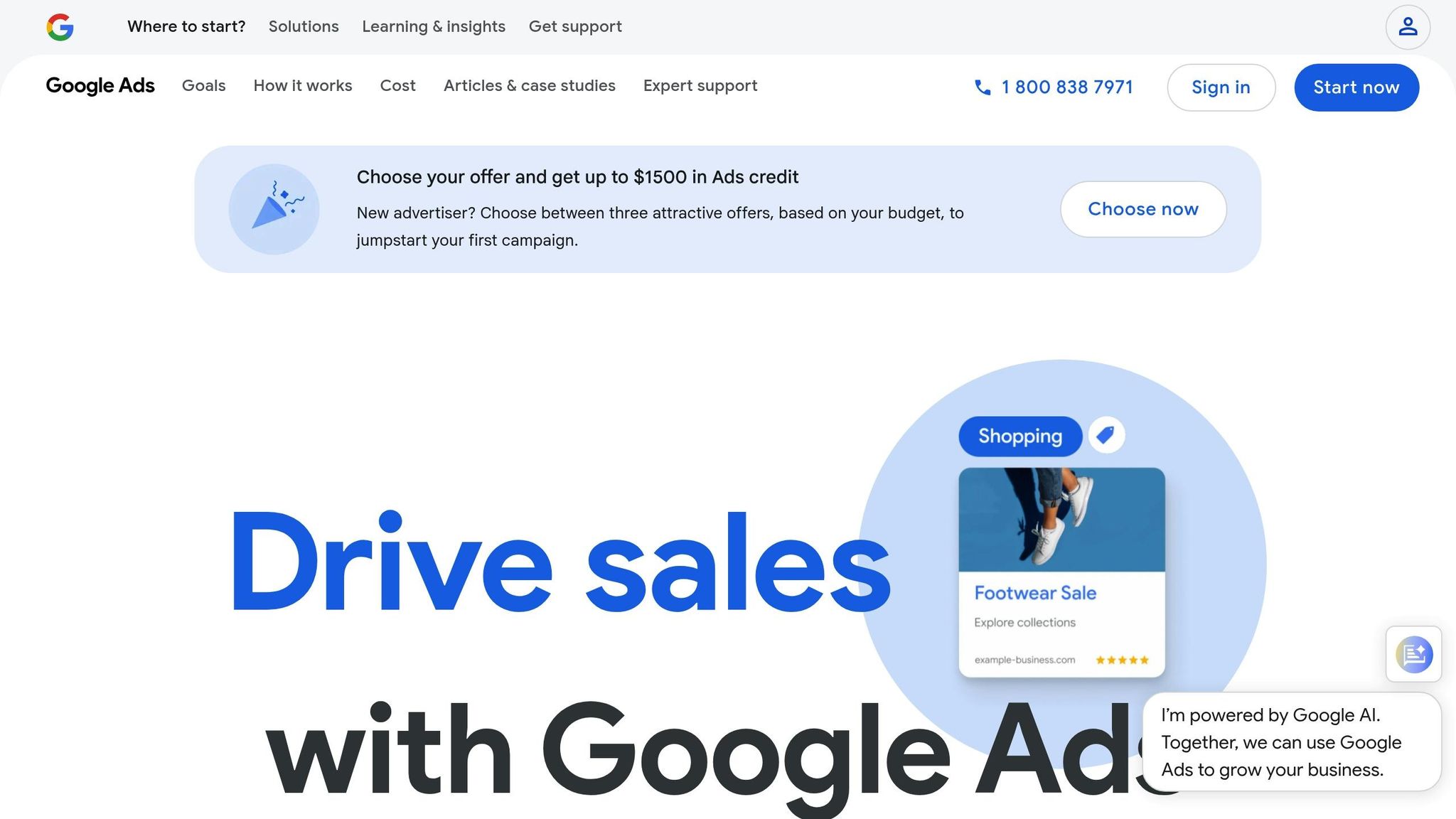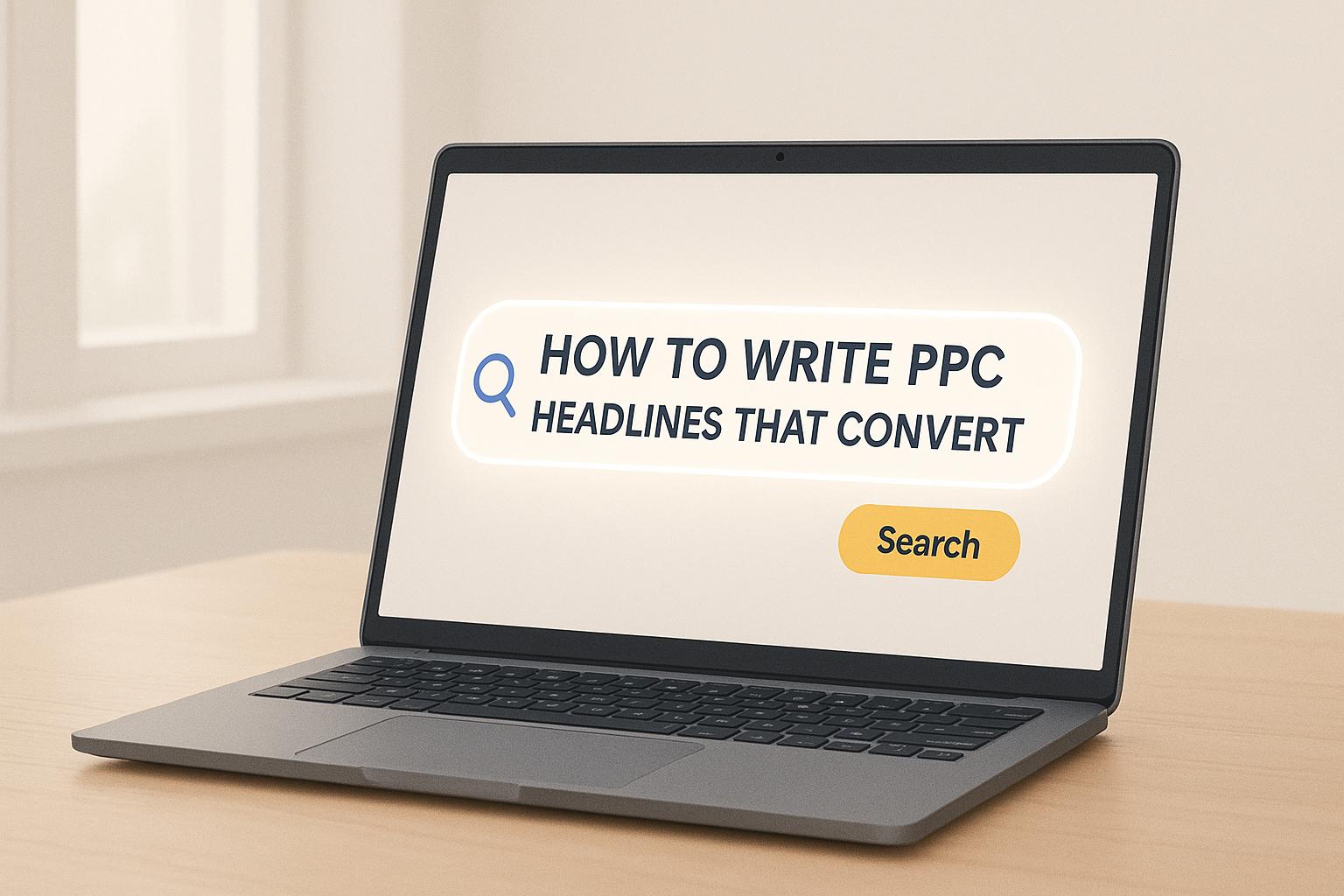How to Write PPC Headlines That Convert
Your PPC headline has less than a second to grab attention and drive clicks. Here’s how to make it work:
- Focus on Relevance: Match the user’s search intent with clear, targeted keywords.
- Highlight Benefits: Show what makes your offer valuable (e.g., discounts, time-saving solutions).
- Create Urgency: Use time-sensitive language like "Limited Time" or "Ends Today."
- Keep It Simple: Use plain, direct language that’s easy to understand.
- Test and Refine: A/B test variations to see what resonates best.
Key PPC Headline Tips:
- Use Keywords Early: Place your main keyword at the beginning for maximum visibility.
- Incorporate Numbers: Headlines with numbers (e.g., "Save 50% Today!") perform better.
- Emotional Appeal: Add curiosity, urgency, or trust signals to drive engagement.
- Dynamic Keyword Insertion (DKI): Customize headlines to match user search terms for better relevance.
- Stay Within Character Limits: Platforms like Google Ads have strict headline limits (e.g., 30 characters per headline).
Quick Comparison: Ad Platform Headline Limits
| Ad Platform | Headline Limit | Description Limit |
|---|---|---|
| Google Ads (Search) | 30 characters (x3) | 90 characters (x2) |
| Google Ads (Responsive) | 30 characters (x15) | 90 characters (x4) |
| YouTube Ads | 15 (short), 90 (long) | 70 characters |
Start by crafting headlines that combine relevance, value, and urgency. Test them, refine them, and watch your click-through rates improve.
Write high-converting Google Ads headlines using this framework

Core Elements of Converting PPC Headlines
High-performing PPC headlines grab attention and drive action by combining key ingredients that resonate with the audience.
Key Ingredients for PPC Headlines
To create compelling PPC headlines, include these three essentials: relevant keywords upfront, a clear benefit, and an emotional hook.
"Great ad headlines are like the flashy displays you see in store windows every day. They’re there to stop you in your tracks, make you picture yourself owning whatever it is they’re selling, and force you to cross the psychological threshold and walk into the store to buy it."
When crafting headlines, consider the specific platform you’re using, as character limits can significantly influence your approach.
Character Limits by Ad Platform
| Ad Platform | Headline Character Limit | Description Character Limit |
|---|---|---|
| Google Ads (Search) | 30 characters (up to 3) | 90 characters (up to 2) |
| Google Ads (Responsive Search) | 30 characters (up to 15) | 90 characters (up to 4) |
| Google Ads (Call-only) | 30 characters (up to 2) | 90 characters (up to 2) |
| YouTube Ads | 15 characters (short), 90 (long) | 70 characters |
| Google Ads (Discovery) | 40 characters (up to 5) | 90 characters (up to 5) |
Given these limitations, it’s crucial to pack your most impactful message into the first few words of your headline. Tools like character counters can help ensure your headline stays within limits.
Avoiding Common PPC Headline Pitfalls
To make your PPC headlines stand out, steer clear of these common mistakes. Research shows that emotionally charged headlines can outperform neutral ones by two to three times.
- Ignoring Keywords: Placing relevant keywords at the start of your headline boosts visibility and relevance.
- Overly Complex Language: Keep it simple – using plain, clear language ensures your message is understood instantly.
- Lack of a Value Proposition: Headlines that highlight specific benefits or include numbers perform better.
- Outdated Offers: Running ads with expired promotions can hurt credibility and waste your budget.
For the best results, focus on crafting headlines that are clear, engaging, and packed with value. Use straightforward language to communicate your offer’s benefits effectively.
Keyword Selection for PPC Headlines
To make your PPC headlines truly effective, choosing the right keywords is a game-changer. Research has consistently shown that well-chosen keywords can boost click-through rates while keeping acquisition costs in check.
Finding the Right Keywords
Start your keyword research by brainstorming terms that are closely tied to your products or services. Focus on phrases that show clear purchase intent. For example, a term like "women’s running shoes" is much more targeted than the generic "shoes."
"The cornerstone of any successful PPC campaign is keyword research – choosing the best keywords to bid on that are most likely to result in clicks and conversions." – Erin Bell, Author, WordStream
Here are some key strategies for effective keyword selection:
- Begin with broad terms, then narrow them down to high-intent, specific phrases.
- Use action-oriented words like "buy," "best," or "compare" to attract customers who are ready to make a decision.
- Dedicate around 15% of your PPC management time to keyword research and ongoing optimization.
Once you’ve identified your keywords, strategically incorporate them into your ad headlines to enhance relevance and visibility.
Where to Put Keywords in Headlines
After crafting a strong headline, placing your keywords in the right spots can make it even more impactful. Positioning your primary keyword at the start of the headline ensures it grabs attention immediately.
Tips for effective keyword placement:
- Use your main keyword in Headline 1 for maximum visibility.
- Incorporate related keywords or highlight benefits in Headline 2 to reinforce your message.
- Include location-specific keywords when targeting local audiences.
Using Dynamic Keyword Insertion
Dynamic Keyword Insertion (DKI) is a powerful tool that customizes your ad headlines to match user search terms, improving relevance and engagement.
Here are some examples of successful DKI usage:
| Company | DKI Implementation | Results |
|---|---|---|
| HomElectrical | Combined DKI with manual optimization | 32% increase in clicks |
| Sheertex® | Applied DKI for product-specific searches | Enhanced ad relevance for "women’s hosiery" searches |
"DKI can be a useful tool when running Google ads. However, you want to make sure whoever is managing the campaign(s) is not just applying DKI and running ads without double-checking ad copy and landing page content to ensure everything will make sense from a searcher’s point of view." – Sam Yadegar, CEO of HawkSEM
To get the most out of DKI, follow these best practices:
- Create default headlines to handle longer or unexpected search queries.
- Ensure your landing pages align with all keyword variations used in the campaign.
- Regularly monitor DKI performance to identify areas for improvement.
- Group similar keywords together to maintain relevance and clarity.
Psychology Tactics for Better Click Rates
Psychological triggers play a big role in driving clicks. For instance, headlines that include emotional words see a whopping 70% increase in shares.
Writing Emotionally Effective Headlines
"Most people believe that choices they make result from a rational analysis of available alternatives. In reality, however, emotions greatly influence and, in many cases, even determine our decisions".
The right emotional appeal can make your headlines irresistible. Here’s how different emotions can shape your headline structure:
| Emotion | Structure | Example |
|---|---|---|
| Curiosity | Question + Benefit | "Want to Cut PPC Costs by 50%?" |
| Urgency | Time + Value | "24-Hour Flash Sale – Premium Tools" |
| Trust | Social Proof + Offer | "Join 10,000+ Marketers Who Save" |
| Achievement | Goal + Timeline | "Double Your ROI in 30 Days" |
Best Words for PPC Headlines
Crafting a compelling PPC headline starts with choosing the right words. Some high-impact options include:
- Action verbs: Words like "Get", "Discover", or "Transform" inspire immediate action.
- Power words: Terms such as "Exclusive", "Essential", or "Premium" grab attention.
- Trust signals: Phrases like "Guaranteed", "Proven", or "Certified" build credibility.
- Urgency terms: Words like "Limited", "Today", or "Now" create a sense of immediacy.
By weaving these words into your headlines, you can spark curiosity and drive engagement.
Time-Limited Offers in Headlines
Time-limited offers are a tried-and-true way to boost click-through rates.
"If you want to make people share and buy, improve your PPC campaign through the use of emotional advertising. This is an effective way to drive your campaign goals".
To make the most of time-sensitive headlines, keep these tips in mind:
- Use specific deadlines: Be precise about timeframes. For example, "48-Hour Sale Ends Tuesday" is much more effective than a vague "Limited Time Only."
- Highlight scarcity: Let people know that supplies or availability are limited to create urgency.
- Keep urgency authentic: With users spending less than 0.7 seconds on an online ad, urgency needs to feel real and believable to grab attention.
sbb-itb-dcae4ad
Testing and Improving Headlines
Testing your PPC headlines is essential for maximizing their impact. With only 20% of readers moving beyond the headline, careful testing can make or break your campaign’s success.
How to Test Different Headlines
Taking a data-driven approach to testing your headlines ensures you’re not relying on guesswork.
"A/B testing eliminates uncertainty by identifying which headline elements resonate best. Focus on testing one element at a time, using data from multiple variations over a complete business cycle."
Here’s a quick guide to effective headline testing:
| Testing Element | Minimum Requirement | Best Practice |
|---|---|---|
| Sample Size | 1,000 clicks per variation | 2,000+ clicks for more accuracy |
| Test Duration | One full business cycle | At least 2-4 weeks |
| Variables | Test one element at a time | Concentrate on headline components |
| Statistical Confidence | 95% confidence level | Use platform tools to track |
For the best results, make sure your tested headlines align seamlessly with your landing pages.
Matching Headlines to Landing Pages
Consistency between your ad headline and landing page can increase conversion rates by up to 25%. The key is to ensure your landing page delivers exactly what the headline promises.
Here are some ways to create alignment:
- Language Consistency: Use the same or closely related wording in both the headline and landing page.
- Value Proposition: Keep the core benefit clear and consistent across both.
- Call-to-Action: Make sure the CTA in the ad matches the landing page.
- Visual Elements: Reinforce the headline’s message with images or design elements that align with the ad.
Headlines for Different Locations
Customizing your headlines for specific regions can significantly influence performance. While the average click-through rate (CTR) for Google Search Ads across industries is 3.17%, location-specific adjustments can help you exceed this benchmark.
Consider these factors when tailoring your headlines:
- Local Language: Use terms and phrases that match regional preferences.
- Cultural References: Incorporate references that resonate with the local audience.
- Time Zones: Schedule time-sensitive offers to align with local timing.
- Regional Pricing: Display prices in the appropriate local currency.
Keep an eye on your Quality Scores when making these adjustments, as better scores can lead to improved ad placements at lower costs. Use analytics tools to track performance across different regions and refine your strategy based on the data you gather. This localized approach can help you maximize engagement and ROI.
Ready-to-Use Headline Templates
Crafting PPC headlines that convert doesn’t have to feel like guesswork. By using proven templates, you can create headlines that emphasize clarity, relevance, and urgency – key elements for grabbing attention and driving clicks.
Headlines with Numbers
Numbers are a powerful tool in headlines. They catch the eye and make your offers feel more concrete and reliable. In fact, a BuzzSumo study of 100 million headlines found that those featuring numbers performed better in terms of engagement and click-through rates.
Here’s how you can use numbers effectively:
| Number Type | Example | Why It Works |
|---|---|---|
| Exact Savings | "Save $3,285 on Annual Utilities" | Specific figures feel trustworthy |
| Social Proof | "Trusted by 20,000+ Customers" | Builds credibility and trust |
| Time-Based | "2-Day Shipping Guaranteed" | Creates a sense of urgency |
| Percentage Off | "70% Off Premium Plans – Limited Time" | Highlights a compelling discount |
By including numbers, you make your headline both attention-grabbing and persuasive.
Headlines that Ask Questions
Question-based headlines are another way to spark curiosity and boost engagement. Research suggests these types of headlines can increase click-through rates by as much as 150%. While they may delay delivering the full value proposition, they work by appealing to the reader’s curiosity and emotions.
Here are a few examples of question headlines:
- "Are You Fed Up With Your Job?"
- "Would You Like to Be Your Own Boss?"
- "Are You Ready to Transform Your Life?"
Questions like these encourage readers to pause and reflect, making them more likely to engage with your ad.
Headlines with Guarantees
Guarantees are a fantastic way to reduce perceived risk and build trust with your audience. A strong guarantee can directly address concerns and make your offer more appealing.
For example, a time-based guarantee might look like this:
"30-Day Money-Back Guarantee – No Questions Asked"
Other guarantee formats to consider include:
- Performance Guarantees: Highlight how well your product or service works.
- Satisfaction Promises: Reassure customers they’ll be happy with their purchase.
- Time-Based Commitments: Emphasize quick results or delivery.
- Quality Assurances: Focus on the reliability or craftsmanship of your offering.
Conclusion: Steps to Write Better PPC Headlines
Creating high-converting PPC headlines requires a thoughtful, data-driven approach. Did you know that PPC ads drive 50% more conversions than organic content? That’s a compelling reason to refine your strategy.
To recap, here are two headline components that can significantly boost your ad performance:
1. Keyword Strategy and Placement
Positioning primary keywords at the beginning of your headlines not only enhances relevance but also improves your Quality Score. Craft your headlines to align with user intent – whether they’re seeking information, navigating options, or ready to make a purchase.
2. Emotional Impact and Trust
Combine emotional triggers with clear benefits and guarantees. This approach resonates with users while building confidence in your offer.
| Headline Element | Impact on Performance |
|---|---|
| Emotional Words | 70% more shares |
| Specific Numbers | Builds credibility |
| Clear Guarantees | Reduces perceived risk |
| Keywords First | Boosts Quality Score |
As highlighted earlier, continual testing is essential for success. For instance, aligning landing pages with your headlines can increase conversions by 65%. Additionally, using tailored calls-to-action can outperform generic phrases like "learn more" by an impressive 202%.
"Searchers click on ads because they’re trying to solve problems or gain information. And searchers, like most humans, are impatient. That’s why hyper-focused and clearly-relevant landing pages are so effective."
- Tanya Ferrell, Paid Search Manager
If you’re looking to fine-tune your PPC campaigns, the PPC Team provides in-depth audits and optimization services. By combining smart keyword placement, emotional resonance, and consistent testing, you can craft headlines that truly convert.
FAQs
How can I use Dynamic Keyword Insertion (DKI) to create better PPC headlines?
Dynamic Keyword Insertion (DKI) is a powerful tool for making your PPC ad headlines more relevant to users by automatically incorporating their search terms. Here’s how to use it effectively:
- Get the syntax right: Use
{Keyword:Default Text}in your headline. This allows the ad to dynamically include the user’s search term, while showing a default phrase if the term doesn’t fit or isn’t available. - Stick to relevant keywords: Ensure the keywords you choose closely match your product or service. This keeps your ads aligned with users’ intent and helps attract the right audience.
- Track your performance: Keep an eye on your campaign data to see which keywords are driving clicks and conversions. Use this insight to fine-tune your strategy and improve results.
By customizing your headlines with DKI, you can make your ads more appealing to users and potentially boost your conversion rates.
How can I make my PPC headlines align better with my landing page content?
To make the user experience as smooth as possible, align your PPC ad headlines with the content on your landing page. Start by mirroring the headline on your landing page with the one in your ad – this consistency not only reinforces your message but also helps build trust with your audience. Use the same keywords in both places to enhance relevance and improve your Quality Score. Be clear about your value proposition and ensure your call-to-action (CTA) matches seamlessly across the ad and landing page to meet user expectations. Lastly, keep the design and tone consistent between the two to create a polished and professional experience.
How can I choose the best emotional triggers for my PPC ad headlines to boost conversions?
To craft compelling PPC ad headlines, start by identifying what drives your audience emotionally. Focus on key emotions such as urgency, trust, excitement, or aspiration. Here’s how you can tap into these feelings:
- Create urgency with limited-time offers that spark a fear of missing out (FOMO).
- Build trust by showcasing customer testimonials or reviews that validate your claims.
- Motivate action with language that speaks to your audience’s aspirations and goals.
When your messaging aligns with these emotional triggers, your ads become more engaging, leading to higher click-through and conversion rates.

